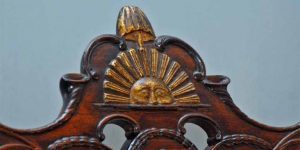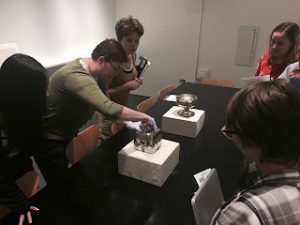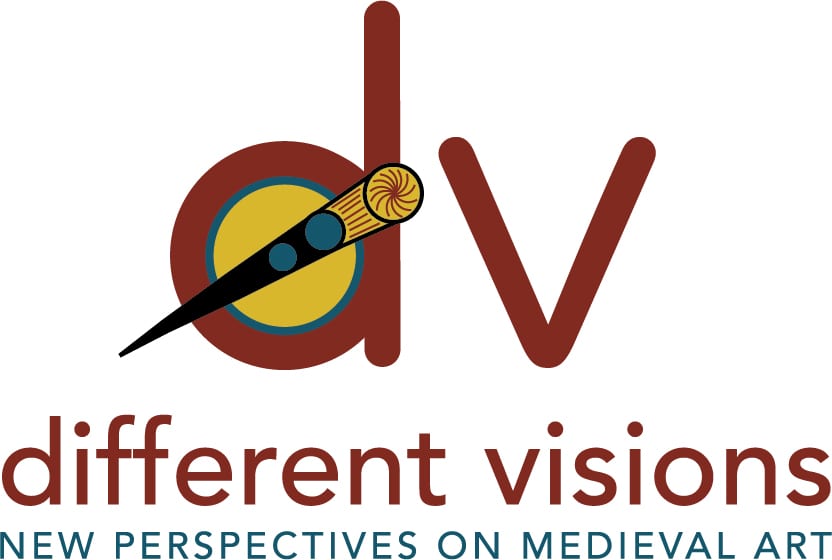Teaching Medieval Art History in a Time of White Supremacy

John Folwell, “Rising Sun” armchair made for the Speaker of the Pennsylvania House of Representatives, ca. 1779. Image via Wikimedia Commons
I find Washington’s armchair to be a fitting example for thinking about how to weaponize the medieval art history syllabus in 2017. As I write, white nationalists march on Charlottesville in part to pay homage to Thomas Jefferson and Robert E. Lee. Commentators like Dorothy Kim have pointed out the special interest that Jefferson and the founders had in the Middle Ages. Mary Dockray-Miller recently charted a short history of medievalism and Anglo-Saxonism in the United States, connecting Confederate fascination with Old English to persistent ideas of whiteness in American discourse. The contemporary mobilization of the discipline by white supremacists has deep roots.
And so, as recent events at Leeds and elsewhere have made clear, white supremacy should be on every medievalist’s radar. The powerful critiques and urgent interventions made by scholars of color have contributed outsize work in making the rest of us aware both of how ready-to-hand medieval history has been for white supremacists and of how much work there is to do inside the academy. One of the most pressing challenges, I think, is how we can find new ways to teach our subject. (And not just to undergraduates; I also teach art history at Stateville Correctional Center, a maximum-security prison, with the Prison+Neighborhood Arts Project.) By pointing out the complexity of objects, teaching forms of visual literacy, and providing students with a baseline knowledge of how to read resilient iconographies of power, art historians have a great deal to contribute. (I’m indebted to Maggie Williams’ recent discussion of “Celtic” crosses for an example of why art historians need to contribute their expertise to the efforts to resist white supremacy.)
This summer, I taught the Introduction to Medieval Art course at the University of Chicago. I wanted to craft a syllabus that would give my students a sense of the disciplinary conversations around medievalism and white supremacy, Islamophobia, and misogyny (a contested term in the literature, to be sure, but one which I use to name both the historic operations of gendered violence and the ongoing modern and contemporary misogyny against women in the academy). I also wanted to help my students develop skills that would enable them to recognize and respond to these issues in both popular and scholarly discourses. And, finally, I wanted them to understand the Middle Ages as the rich, diverse era we know it was. These problems took on real urgency at the University of Chicago last year, as revelations about the actions of local medievalists prompted a series of productive conversations among students and faculty. These conversations included a public event devoted specifically to pedagogy.
Here, I want to share some of the ways that I tried to open up the field. I’m sure there are many ways to set about this task, and I present these notes in the spirit of a working draft towards a better medieval art history.

Students from Introduction to Medieval Art examine objects at the Smart Museum of Art with Sara Hindmarch, Head Registrar.
1) Authors
Many of the Great Medieval Art Historians are men; Meyer Schapiro, Otto Pächt, Kurt Weitzmann, et al. I tried to write a syllabus that would feature predominantly non-male authors and ended up with a ratio of seven men to twelve women. This excludes primary sources, but even here it’s possible to use, say, Galla Placidia rather than Abbot Suger to talk about patronage. There are very few scholars of color on my syllabus; next time I might consider assigning Seeta Chaganti’s analyses of reliquaries or the danse macabre, Geraldine Heng’s work on Saint Maurice, or Benjamin Liu’s discussion of mudejar work. Jonathan Hsy and Julie Orlemanski have helped to organize a crowd-sourced bibliography of sources dealing with race and medieval studies, which includes much good work by scholars of color (although it still has relatively few art-historical sources).
2) Topics
I tried to do two things with my selection of class topics: first, to teach canonical topics in less-canonical ways, and second to substitute non-canonical topics for canonical ones. As an example of the former, I built in a section on the arts of the book. This is a fairly conventional entry in a survey course, and I had the students read some fairly conventional articles in preparation. But when we visited our library’s Special Collections in order to analyze medieval codices, I asked the students to practice discussing paleography, illumination, and facture on a selection of manuscripts that included Haggadot and Islamicate treatises like our library’s facsimile of the Paris Kitāb al-Diryāq (Bibliothèque nationale de France, MS Arabe 2964).
As an example of the latter, I included a session on Islamic science (asking the students to skim a short, digitized Metropolitan Museum of Art catalogue and read an excellent essay by Moya Carey). I also devoted a class explicitly to women artists, building on an earlier discussion devoted to Hildegard von Bingen as a case study of visionary women. This also gave me the opportunity to discuss gender more broadly; I circulated Karl Whittington’s “medieval” entry in the inaugural ‘keywords’ issue of TSQ: Transgender Studies Quarterly as an optional reading and the students engaged in a robust discussion of gender as an analytic category in art history.
3) Narrative
I didn’t try to make every class session explicitly about white supremacy. Rather, I tried to use each discussion to concentrate on one aspect of the Middle Ages that could be connected to a concrete analytic skill. So, in our class on Byzantium I finished a close reading of the Hagia Sophia by showing nineteenth-century paintings of the Byzantine court by French academician Jean-Joseph Benjamin-Constant. I used his sumptuous, problematic images to introduce the concept of Orientalism, a key term of analysis that would later recur in our discussions of medieval Sicily. In our class on post-Lateran IV piety, we moved from a discussion of Saint Francis and the stigmata (using Paroma Chatterjee’s fantastic article on Bonaventura Berlinghieri) to a conversation about Jewish blood libel. It’s not hard to connect these practices with nineteenth-century French anti-Semitism, to ask what work the painting of the crucified William of Nowich was doing on the rood screen in Loddon, to point to the French hamlet of La mort aux Juifs, or to ask why the church at Sternberg still exhibits a table upon which Jews supposedly martyred a host in 1492.
My goal here was to build the students’ knowledge cumulatively. By connecting each class to a specific way in which the medieval material had been manipulated by modern and contemporary ideologues, and by using each class to discuss and practice an interpretive method that would help the students to deconstruct specific features of white supremacist discourse, I hoped to slowly build the students’ skills. This way, I anticipated that they would be able to generate their own robust, persuasive critiques; essentially, I wanted to teach them the process of identifying white supremacy as well as the content which Richard Spencer and his ilk find so appealing. I prepared a few key essays and news items to send to the students after each class in case the discussion didn’t get to present-day events.
An additional note: I found site visits to be really helpful in facilitating conversation about the theories and methodologies of medievalism. Since museums are always constrained by their collections and are almost always forced to present medieval art in the form of a narrative, they’re great places to get students talking about the discipline’s construction. We visited the newly-installed medieval galleries at the Art Institute of Chicago about halfway through the class, and the students quickly identified the display’s biases. The public art landscape of Chicago is also ripe for this kind of analysis; as I’ve discussed elsewhere, the lakefront boasts such objects as an eighteen-foot Roman column donated and inscribed by Mussolini.
4) Getting Explicit
The final class day was devoted explicitly to the politics of the postmedieval. We visited the study room at our campus museum and looked at a selection of nineteenth-century and early twentieth-century medievalist things: a German Romantic painting depicting the sleep of Frederick Barbarossa, a bourgeois biscuit tin by Archibald Knox that draws on medieval object and letter forms, and Edmund Johnson’s facsimiles of Irish medieval objects made for the 1893 Columbian Exposition. I wanted the students to reflect on how and why these things presented different visions of the Middle Ages. Primed by Karl Steel’s excellent essay on white supremacist appropriations of Viking heritage, they quickly connected the artifacts to the rhetorical strategies employed by Game of Thrones and Lord of the Rings. Sorting through issues of audience, authenticity, and investment in a focused way, they produced a rich set of observations about how the nationalist, white, and Christian supremacist imaginaries have animated medieval history.
There were holes in my syllabus to be sure; and I was fortuitous to have curators from multiple institutions who were willing to facilitate the kinds of encounters with objects that advanced my students’ thinking. My identity as a white, cis, male academic has helped shield me from much of the abuse heaped on medievalists of color; I haven’t received hand-addressed hate mail like Jonathan Hsy, for example. One of the ways white medievalists can stand in solidarity with our colleagues is by decolonizing our syllabi and our classrooms, by making our teaching part of the solution as we combat the ongoing appropriation of our field. I welcome suggestions about how to do this better in the future. Our students deserve it.
Acknowledgements: I’m grateful to Jack Dragu and Emily Wood for their comments on this text. My seminar students deserve real thanks. A fantastic group of smart, sensitive, and rigorous thinkers, they recognized what I was trying to do and cared about it. They offered probing critiques and welcome feedback, and affirmed my belief that, even if many medievalists decline to be accomplices in our field’s decolonization, the project matters profoundly to our students and, correspondingly, to the next generation of medievalists. Berit Ness, Sara Hindmarch, and Catherine Uecker generously facilitated my seminar’s on-site object studies.
